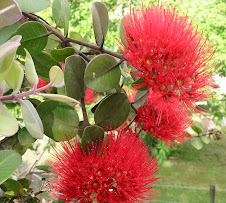I took this photo yesterday where I was working in the slowest to mature block in our orchard. It shows a female kiwifruit flower just open and buds almost open. It is hanging right beside a metal ag beam ( one of the support structures ), the extra heat the ag beam gives off from the sun seems to boost those buds right next to it. All the rest of the orchard blocks have a few open flowers so that means we need to get bee hives in probably Sunday night.( when 10% are open ) We are well up with our bud thinning and pruning and the potential crop looks very promising. SO ALL OF THAT IS GOOD. BUT the threat of the disease PSA is lurking everywhere around us.
It is a year now since the first gold variety kiwifruit vines in Te Puke were found to have the bacterial disease PSA ( pseudomonas syringae pv actinidiae )All those vines in the first infected orchards have been totally pulled outand burnt or buried . But the disease has spread. Every day the number of infected orchards seems to increase. 434 orchards currently have Psa ( 408 are in Te Puke area. ) 72 % of NZs kiwifruit vines are now in priority zones ( that means have some disease nearby ) Waihi has 1; Katikati 3; Tauranga 14; Whakatane 7; Opotiki 1.
Things we know about the disease. Gold varieties are more susceptible, male vines are more susceptible, younger vines are more susceptible. It can be spread in many ways...by the wind, on footwear and clothing,on tools and vehicles, possibly by bees and insects and birds, possibly transferred on pollen artificially applied. There is a lot we still DON"T KNOW.
What is happening as a consequence. Zespri the marketing part of the industry that sells the fruit worldwide and organises the shipping etc are planning to greatly reduce their staff. Growers and all involved working in the orchards are having to take strict precautions to try and not spread the disease. Disinfecting tools, vehicles, footwear, hands clothing between orchards. For us this means we must police this to see this happens. This is what happened yesterday.
A large truck with a hydralada arrived ( photo above on driveway )( note hose for washing vehicles on wall bottom left of photo ) to replace broken insulators on the main high tension power lines that run between Tauranga and Waihi. 2 of their poles cross the bottom end of our property. They needed access to get to them with their vehicle and 3 men. They stopped at the house to get permission and be shown where to go. We gave them an orchard map and list of hazards as we are obliged to do.
"How were they going to disinfect their vehicle and equipment and clothing we asked them? Do you know about PSA we asked them?"
"Oh yes we do," they said."We were going to clean our vehicle on the way OUT!"
"How does that protect us," we asked.? .....
"Well our disinfecting stuff is currently out on Matakama Island," they said.
"Sorry you can't come in. Go and get some more disinfectant please." ( Zespri had provided them with it ) 45 minutes later they had organised themselves and done what we asked .WHAT if we hadn't been home?
So you see it is us who have to be constantly vigilant. I read in one of the magazines that arrived today ( we are constantly being emailed and posted information - ( far more than we can possibly read if we want to work as well ) that the bacteria has been found in trials to survive on leaf litter for 56 days, on wood for 15 days and on plastic for 8 days. That is is very scary.
Some of the down stream effects are land with kiwifruit on it is now worth less than bare land. All packhouses and associated businesses are having to cut down staff numbers. Apart from copper sprays there is very little growers can do to protect as yet uninfected vines.
What does the future hold for growers ...for the BOP which is the largest kiwifruit growing area in new Zealand ?
For us as yet uninfected it means carry on as usual and hope we can bring the lovely crop hanging in the vines to picking time next year. ( it's a bit like the plague or Foot and Mouth, but in kiwifruit vines )
ps. last night we ate the last 2 fruit I had kept from this years' crop, picked in May. They have lasted unrefrigerated since then. There certainly will be less kiwifruit to sell to the world in the next few years.
.
Woman of the day
3 hours ago








5 comments:
What a huge headache all this must be for you! I hope your orchard stays safe.
Wow Ali -- what a fascinating post. I hope you can manage to keep the bacteria at bay -- what a worry!
Let's hope that a solution is found for this problem.....otherwise a whole industry could be wiped out.
How dreadful. In Britain this year, outdoor busy Lizzies got a fungus and died in huge numbers. Of course we don't eat them, but still it must be a huge worry for the producers.
Post a Comment